Amasty Product Feed Magento 2 Extension

We’ve already reviewed some Magento 2 product feed extensions (by Mirasvit, Xtento, and Wyomind), and below, we shed light on another prominent module of this kind – Amasty Product Feed for Magento 2. With the Amasty feed generator, you will be able to efficiently create product data feeds for any marketplace. The Magento 2 module automates feed generation and allows users to adjust data in the feed in line with the requirements of a shopping engine.
If you are looking for a tool that will help you create comprehensive product feeds for various shopping engines, check the following post.

Amasty Product Feed offers pre-made feed templates for core shopping engines, including Google, Amazon, Bing, Shopping.com, Facebook, and more. Their availability radically improves the way you connect your Magento 2 store to third-party platforms. Besides, the Magento 2 product feed extension provides the ability to automate feed creation. If you do not trust the module’s automated functionality, it still offers an opportunity to do everything manually. Moreover, due to flexible conditions, it is possible to create an unlimited number of product feeds that comply with all shopping engine requirements.
Other important features are:
- Feed wizard offering 7 simple steps to generate Google and Facebook product feeds;
- 4 pre-configured templates for Amazon feed;
- Price formats that are easy to configure and use;
- Ability to create custom attribute values for the feed based on the specified conditions;
- Feed generation based on the URL path length;
- Product filtering based on category and attribute sets;
- Ability to skip out of stock, disabled, and not visible items;
- Possibility to exclude specific categories;
- Support for simple, virtual, bundle, downloadable, grouped, and configurable products;
- Various feed formats: CSV, XML, and TXT;
- Scheduling of feed generation;
- Multi-process generation function for speeding up feeds creation;
- Integration with Google Analytics for tracking statistics on sales from shopping engines.
Take a look at what other users think about the Magento 2 product feed extension, and we will proceed to the backend tutorial.

Table of contents
- 1 Backend
- 2 Recent Updates
- 2.0.1 Magento 2 Product Feed 2.5.1
- 2.0.2 Magento 2 Product Feed 2.4.0
- 2.0.3 Magento 2 Product Feed 2.3.5
- 2.0.4 Magento 2 Product Feed 2.2.8
- 2.0.5 Magento 2 Product Feed 2.1.0
- 2.0.6 Magento 2 Product Feed 2.0.0
- 2.0.7 Magento 2 Product Feed 1.9.1
- 2.0.8 Magento 2 Product Feed 1.8.2
- 2.0.9 Magento 2 Product Feed 1.6.0
- 2.0.10 Magento 2 Product Feed 1.5.6
- 2.0.11 Magento 2 Product Feed 1.4.0
- 2.0.12 Magento 2 Product Feed 1.3.1
- 2.0.13 Magento 2 Product Feed 1.2.0
- 3 Final Words
Backend
All feeds are gathered in a grid that consists of 8 columns:
- Checkbox – you can select feeds to generate, delete, or duplicate them in bulk;
- ID – an ID number of each feed;
- Name – a name of each feed: usually illustrates a shopping engine;
- File – a title of the corresponding feed file;
- Mode – a feed can be generated either manually or automatically;
- Store – a relevant store view;
- Generated – last time a feed was created;
- Action – each feed can be edited from here.
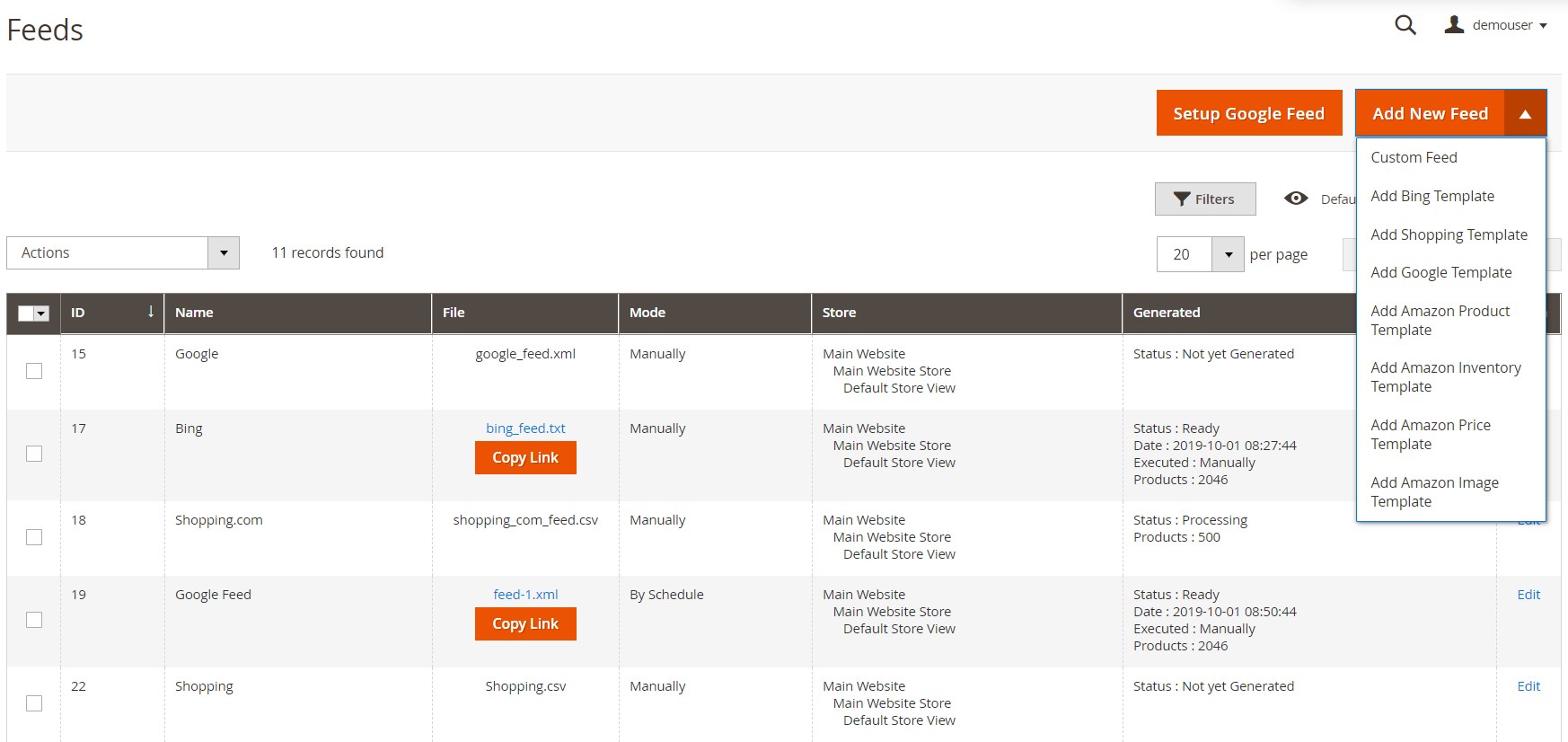
While adding a new custom feed with the Magento 2 product feed extension by Amasty, you have to deal with 7 tabs of settings: General, Content, Format, Conditions, Schedule, FTP Settings, and Analytics.
In the first one, specify a feed name, file name, type (CSV, XML, or TXT), store view, status (active or inactive), and compression type (none, zip, gz, bz). Here, you can also enable excluding disabled, out of stock, and not visible products from your product feed.
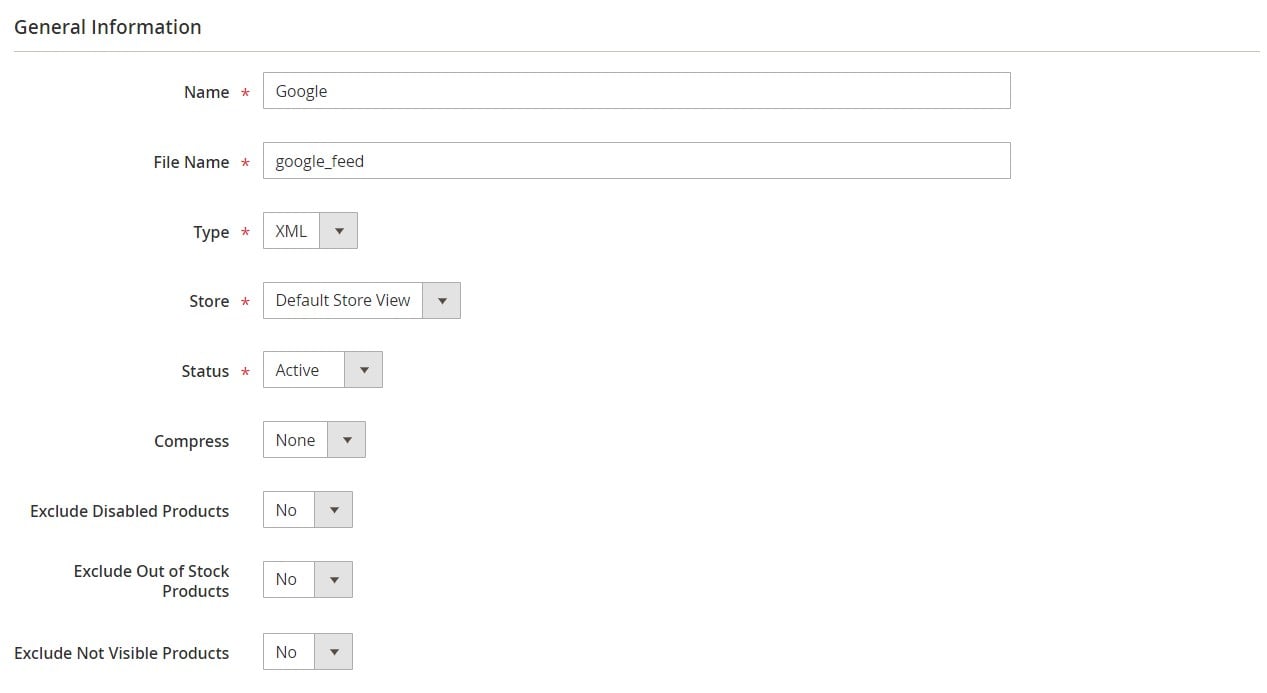
If you select XML as a file format, you will need to configure the options in the Content tab. Here, you should specify info for an XML header, XML tag (in the Item field), content, and XML footer.
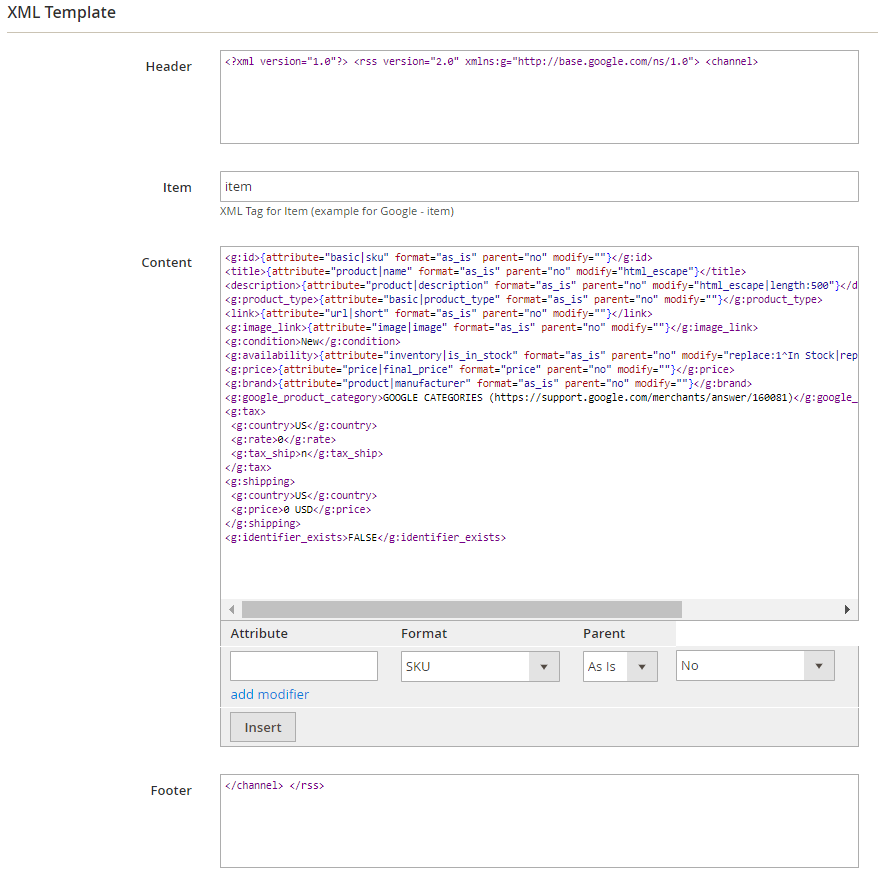
In Format, select currency, decide whether to show its abbreviation, set the number of decimal points, and choose separators for the decimal point and thousands. Next, specify the date format.
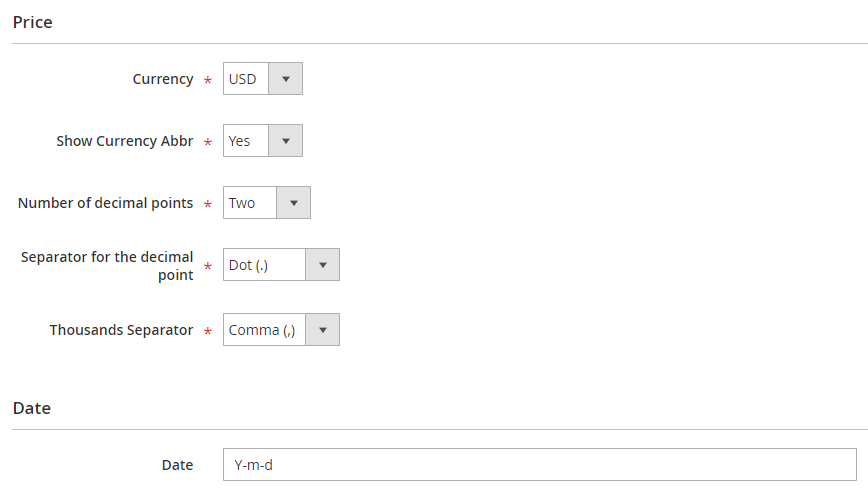
In Conditions, you can create specific conditions with the help of product attributes.
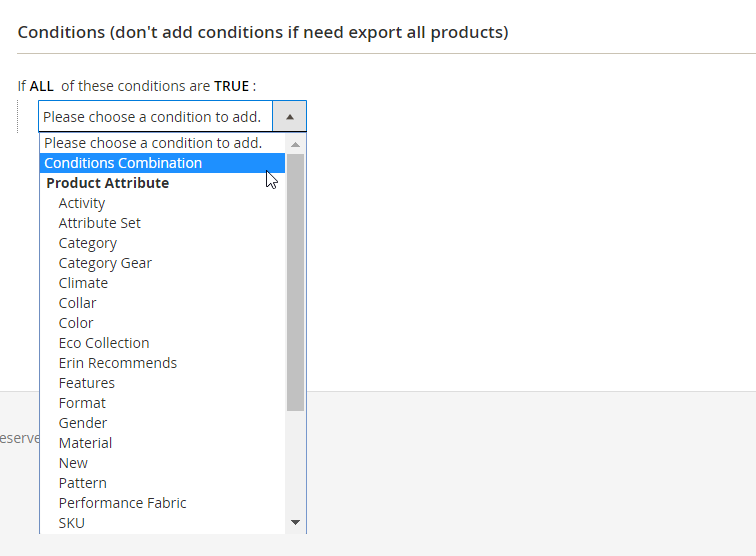
In the Schedule tab, you select whether to generate feed manually or according to a pre-defined schedule.
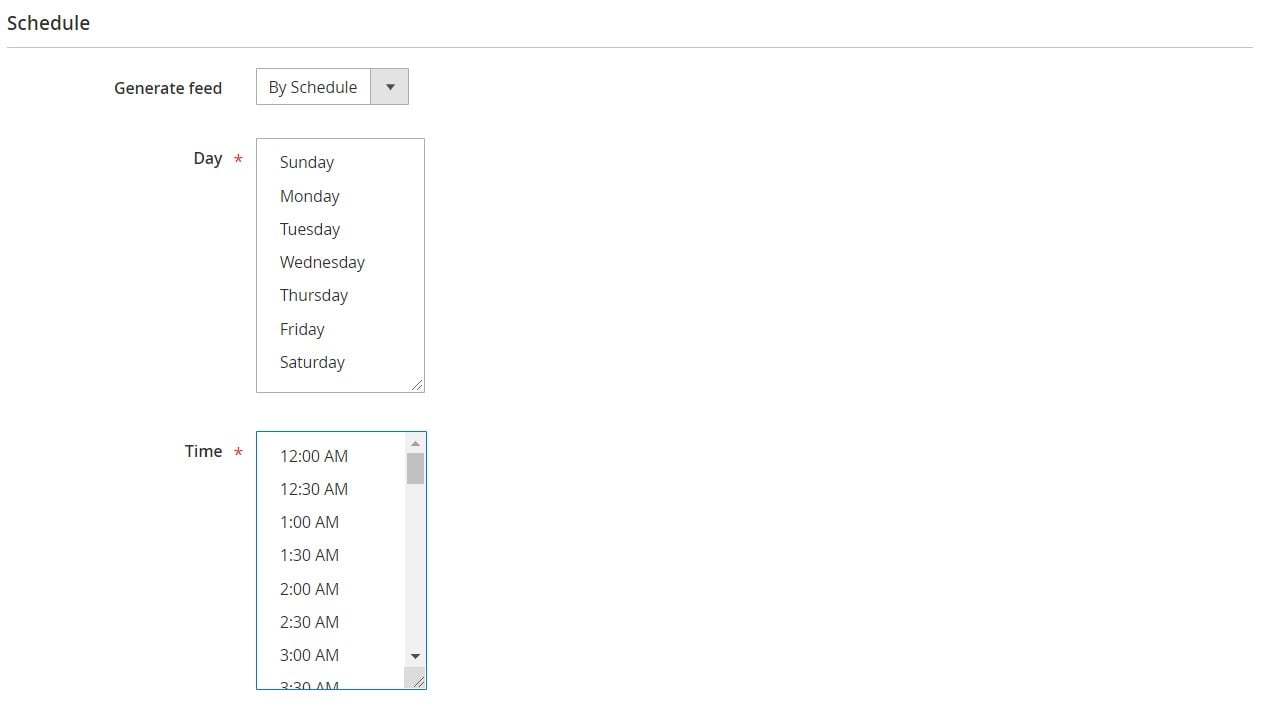
The next section of the Magento 2 product feed extension allows you to enable feed download, specify a server hostname, choose a protocol type (FTP or SFTP), enter the user name, password, and directory path, as well as enable/disable passive mode (for FTP type).
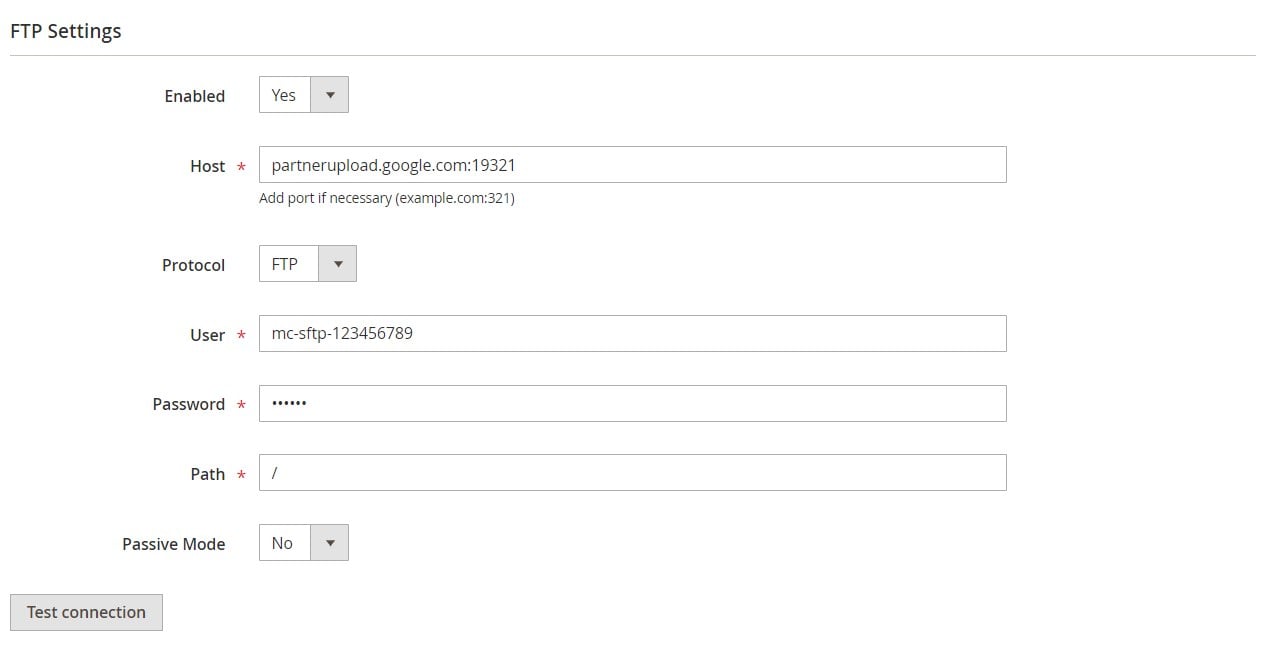
In Analytics, you should set parameters necessary for monitoring your campaign using your Google Analytics account: campaign source, medium, term, content, and name.
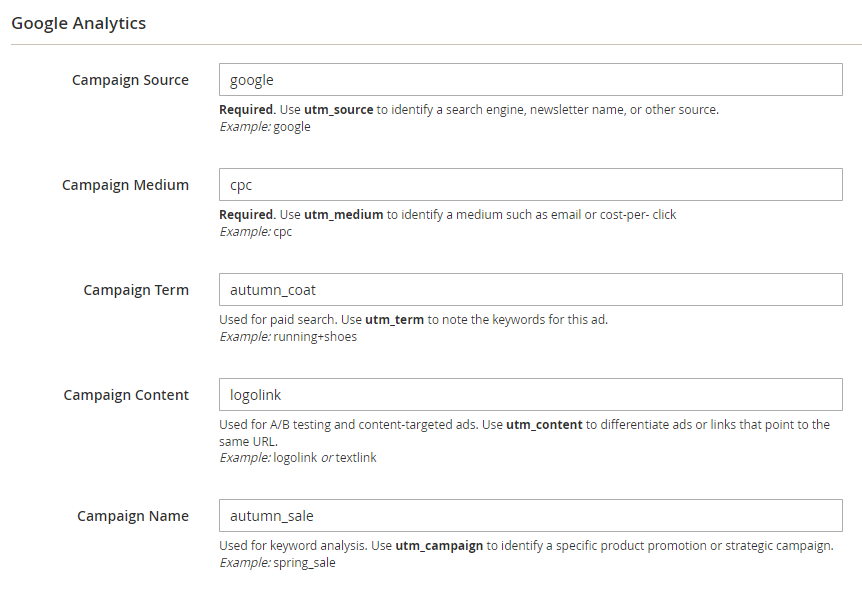
Next important part of the Magento 2 product feed module by Amasty is related to category mapping. All categories are gathered in the following grid:
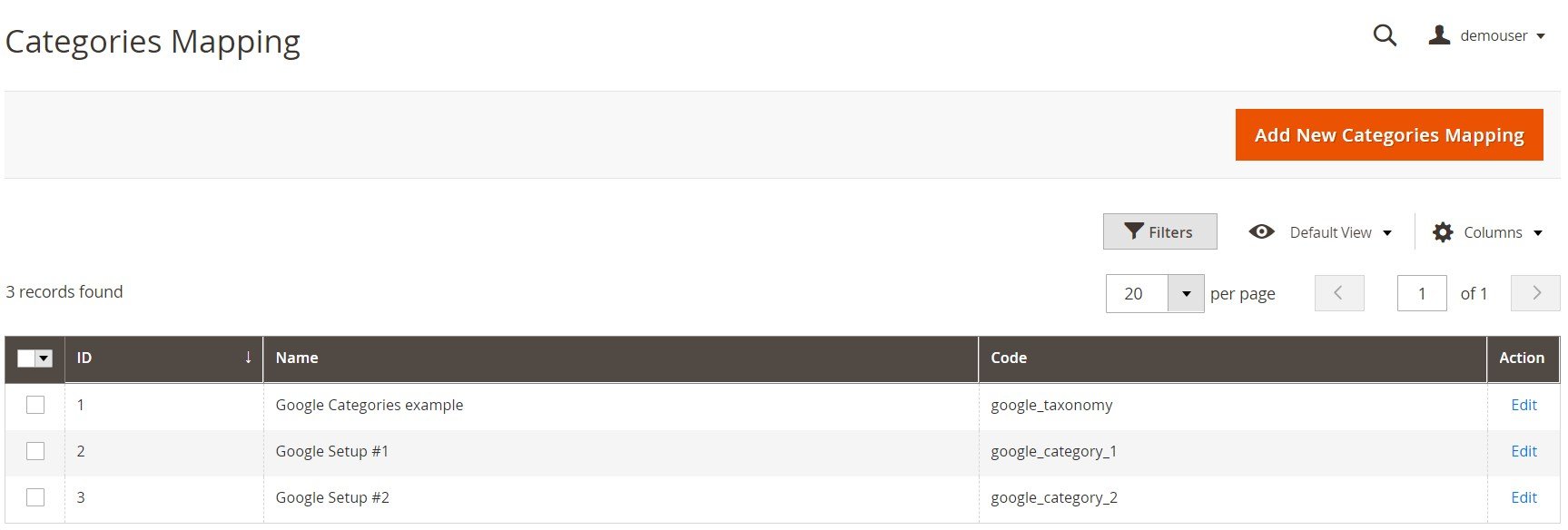
While adding a new category, first, you should specify its code and name.

Next, you can select particular categories that will be excluded from the feed.
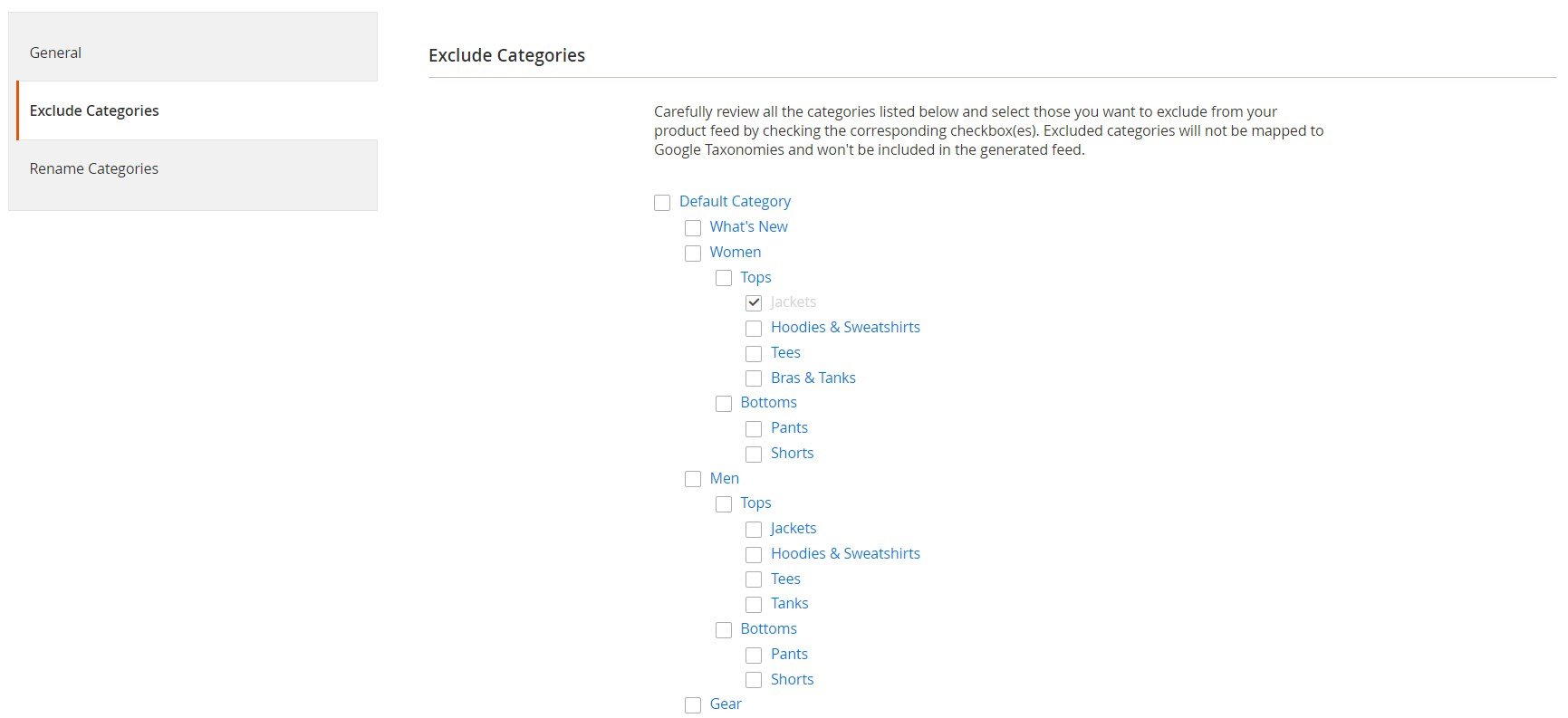
In the next tab on the category edit screen, you can rename categories to adjust them to the Google Taxonomy.
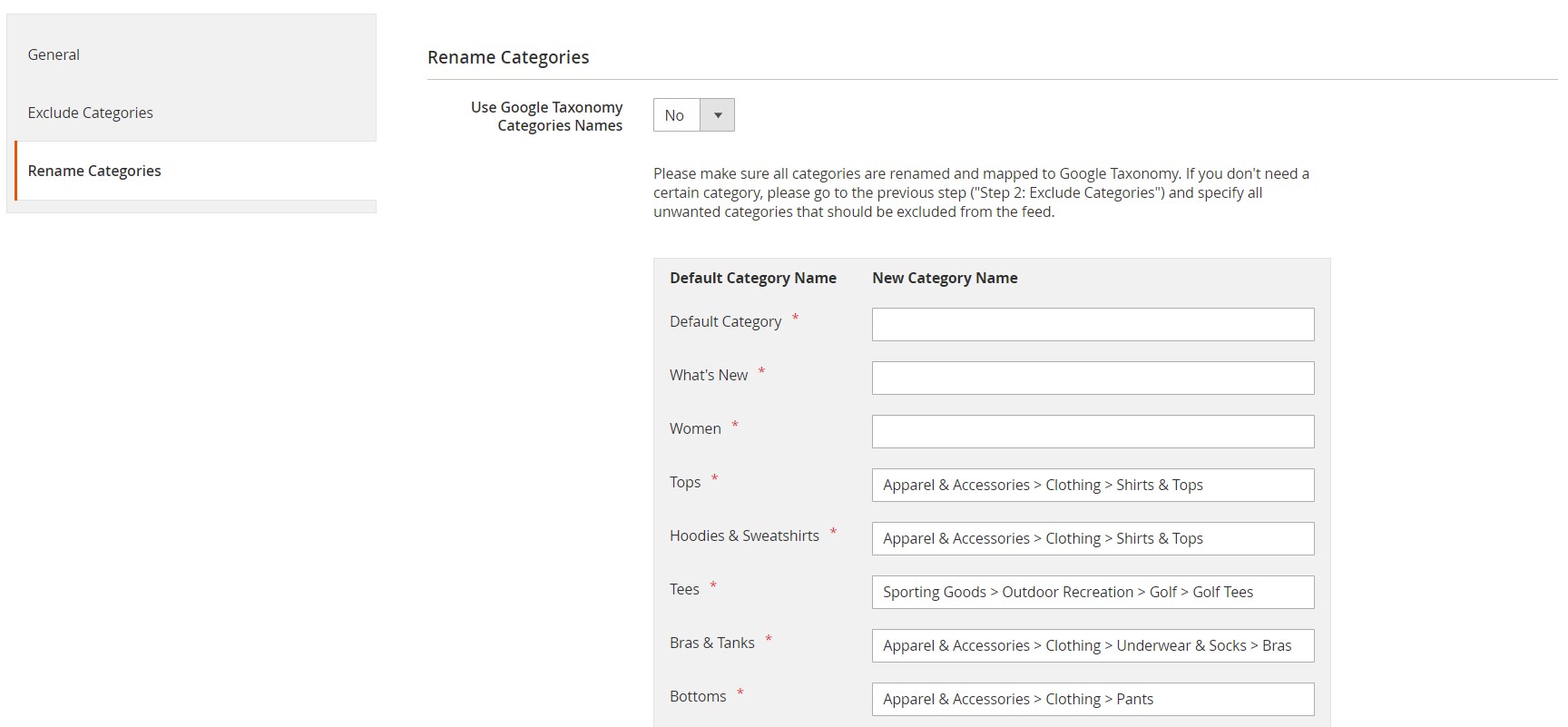
Now, let’s see how to generate a feed using Google Feed Wizard provided by the Magento 2 product feeds extension. The wizard offers 7 steps to create a Google feed.
On the first step, you specify general information for your feed.
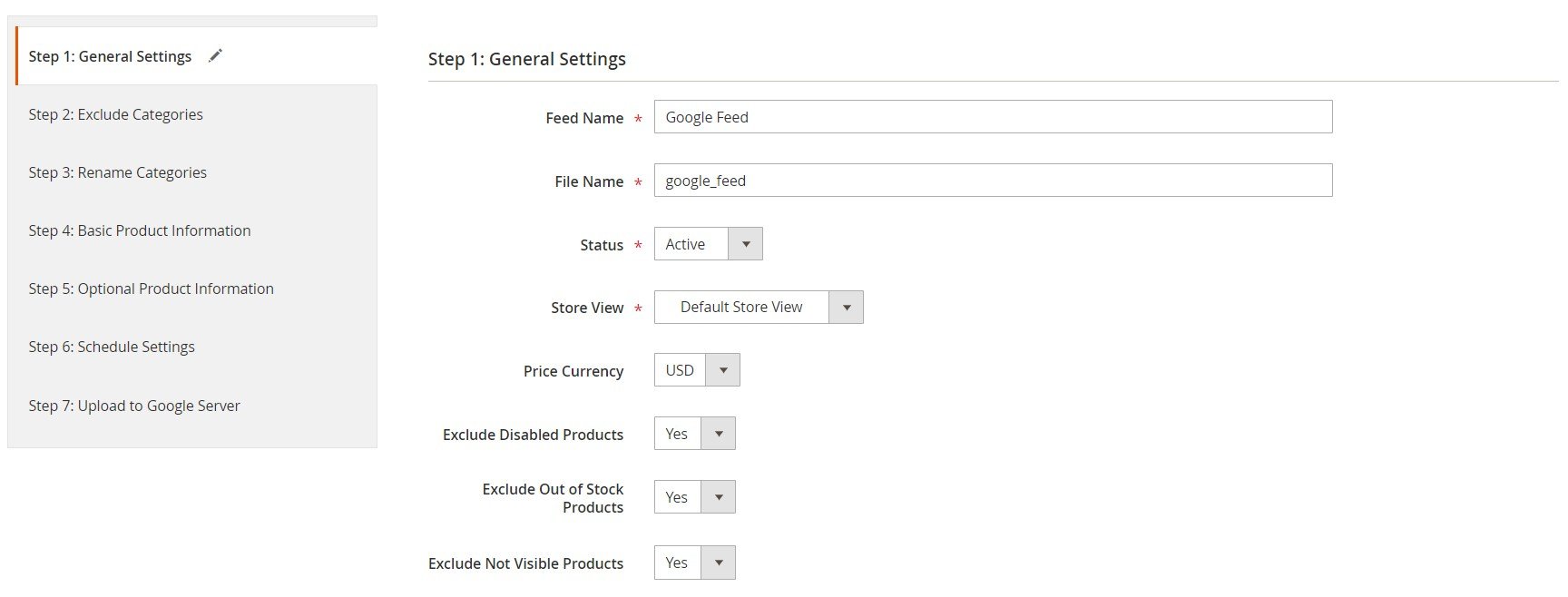
On Step 2, you can exclude selected categories from the generated feed, in the same way as for categories mapping described above.
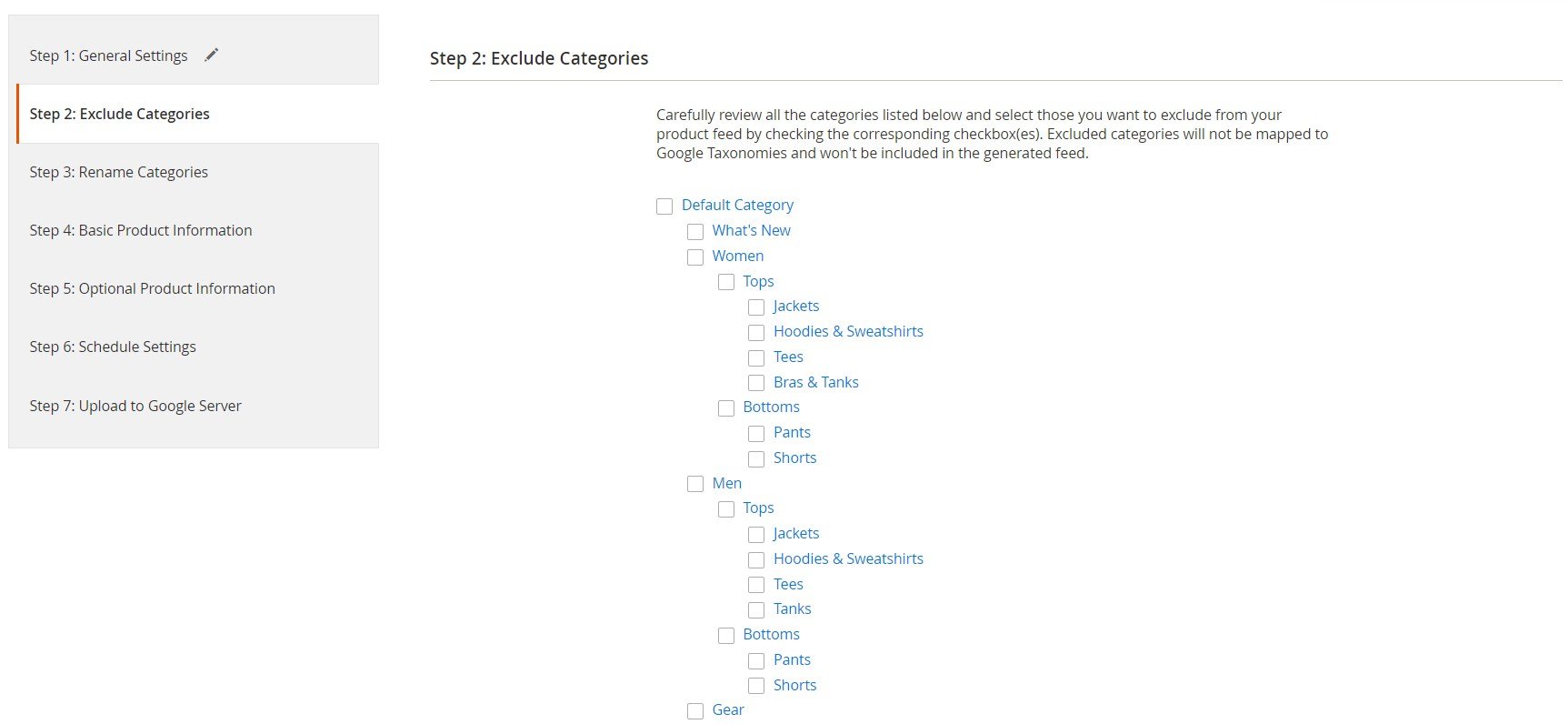
On the next step, you should associate your product categories with the Google Taxonomy.
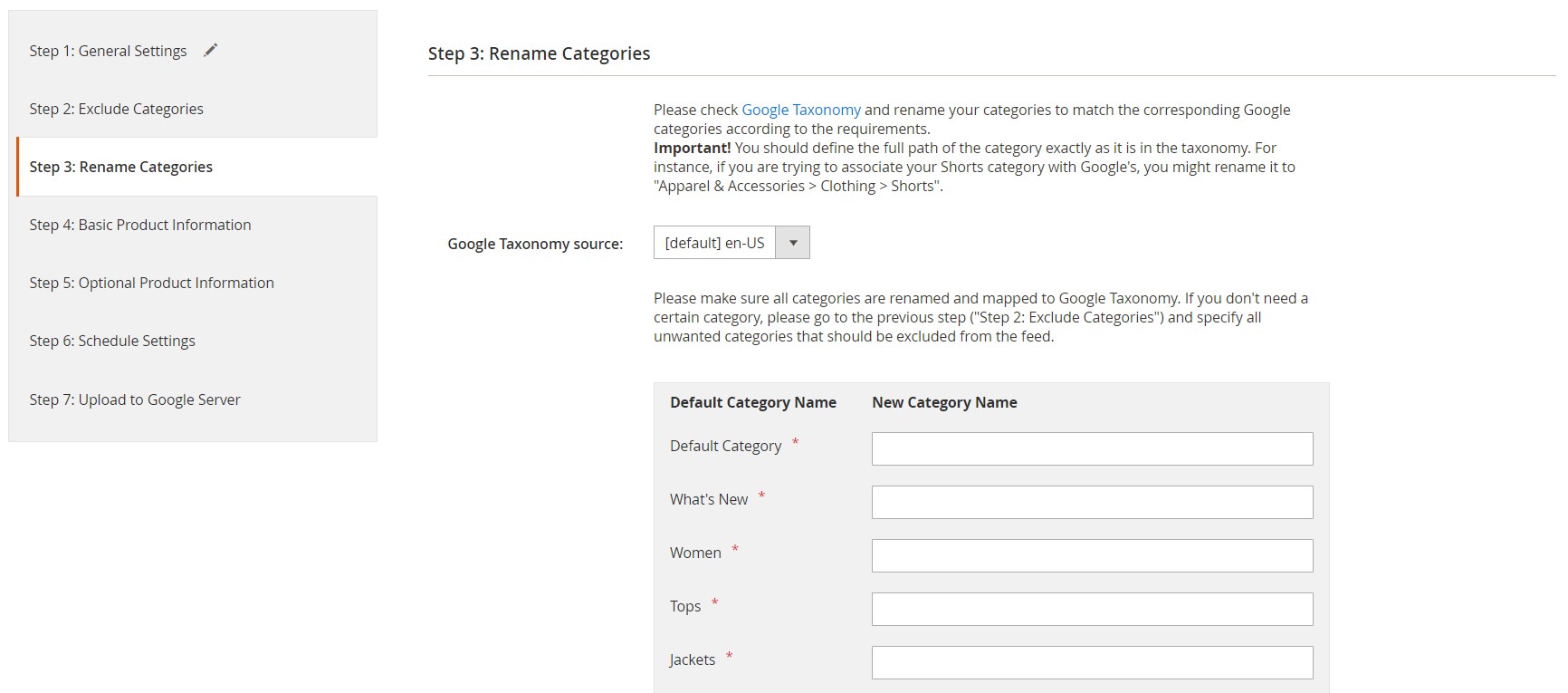
Basic Product Information fields are pre-filled, but you can make necessary changes if required.
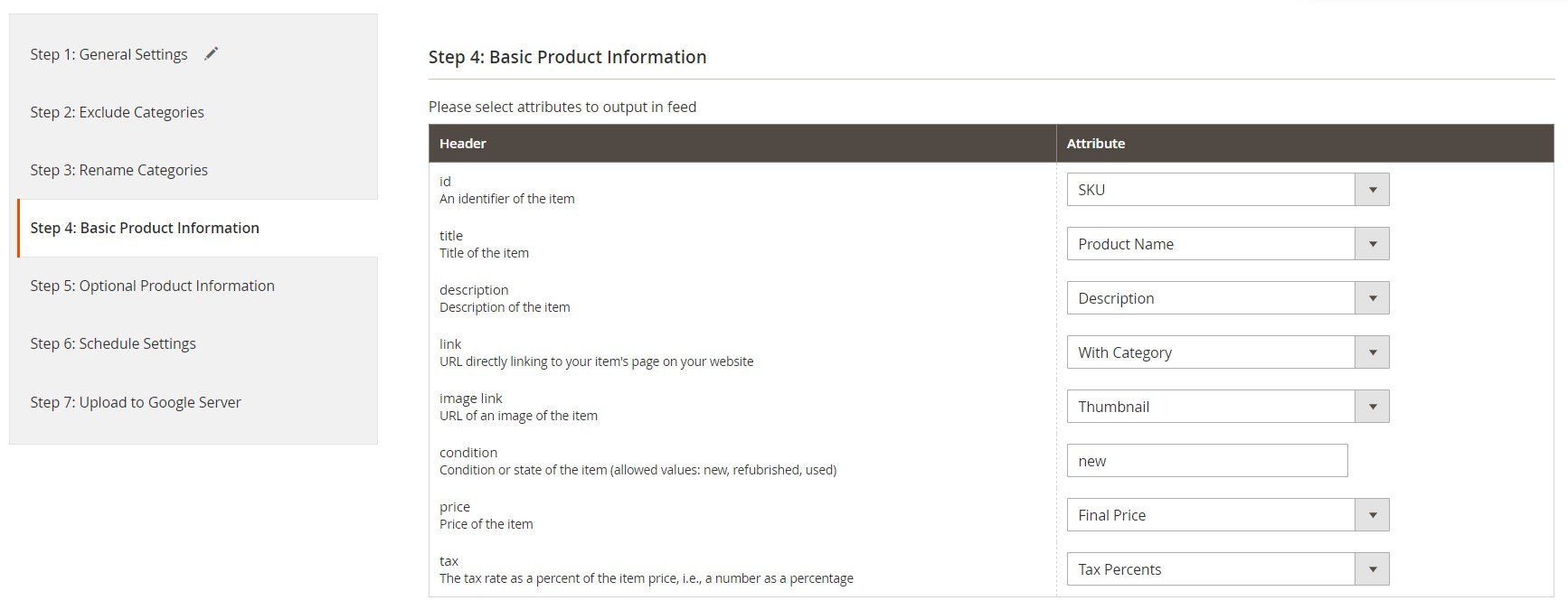
On Step 5, you configure optional product attributes.
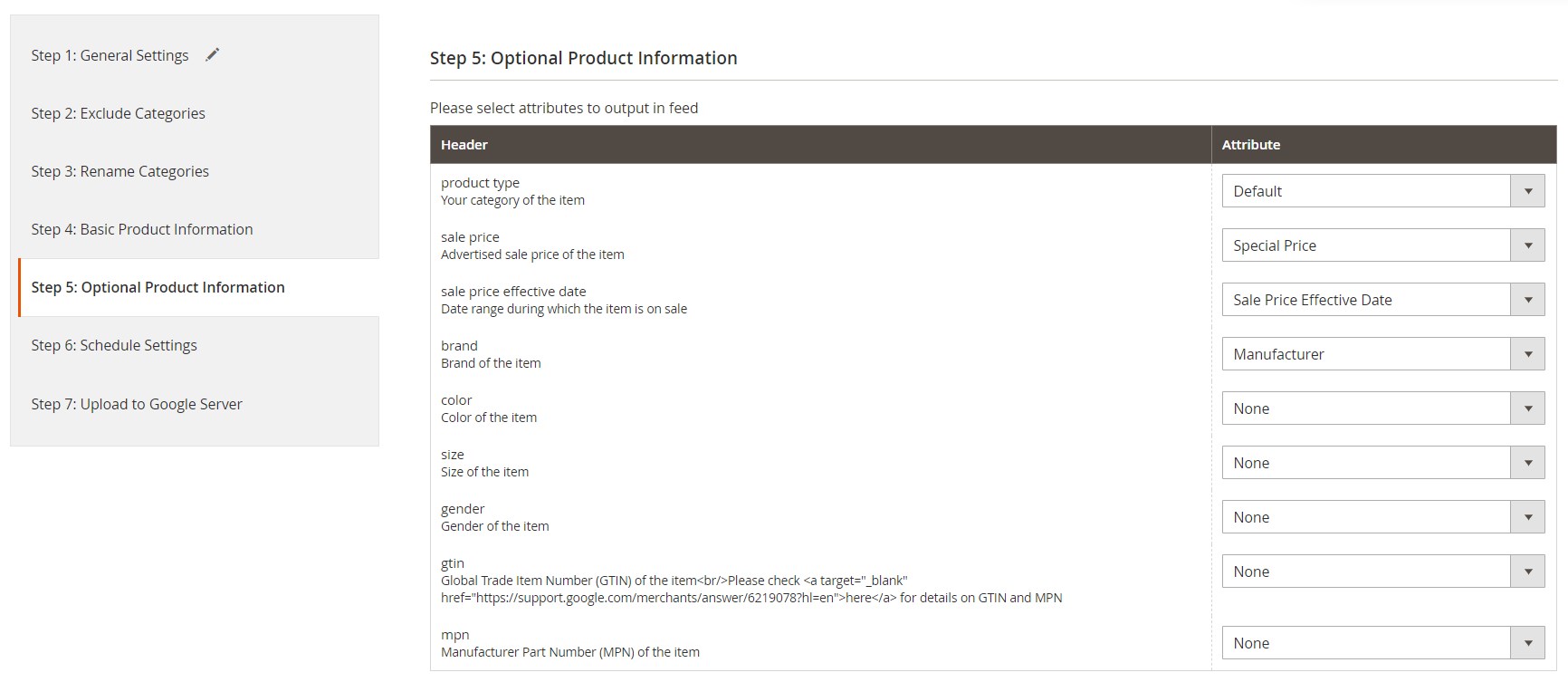
Then, decide how you want the feed to be generated: manually or automatically. Here, you also set a schedule for the automated Google feed update.
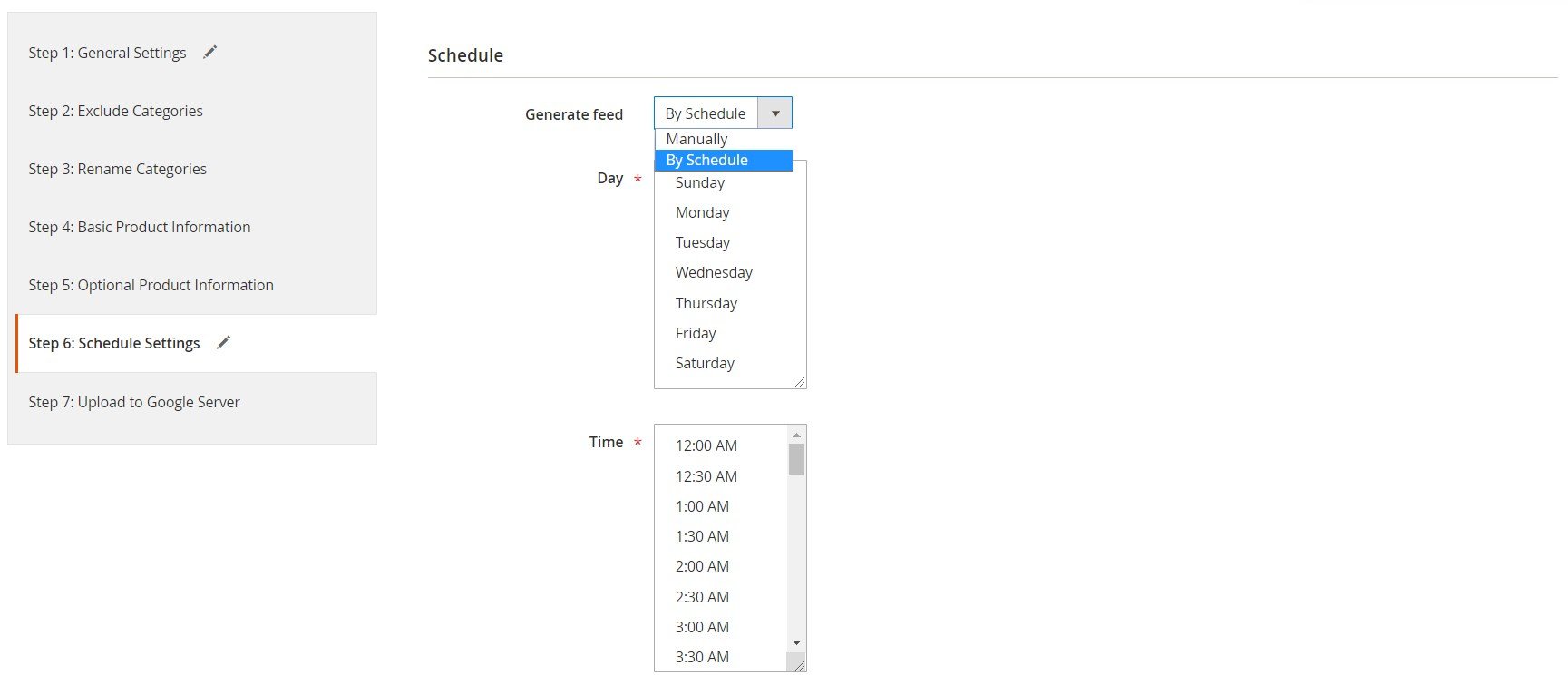
On the last step, specify the data received from the Google Merchant. Here, you should select an upload method and fill in the fields with the host, user, password, and path.
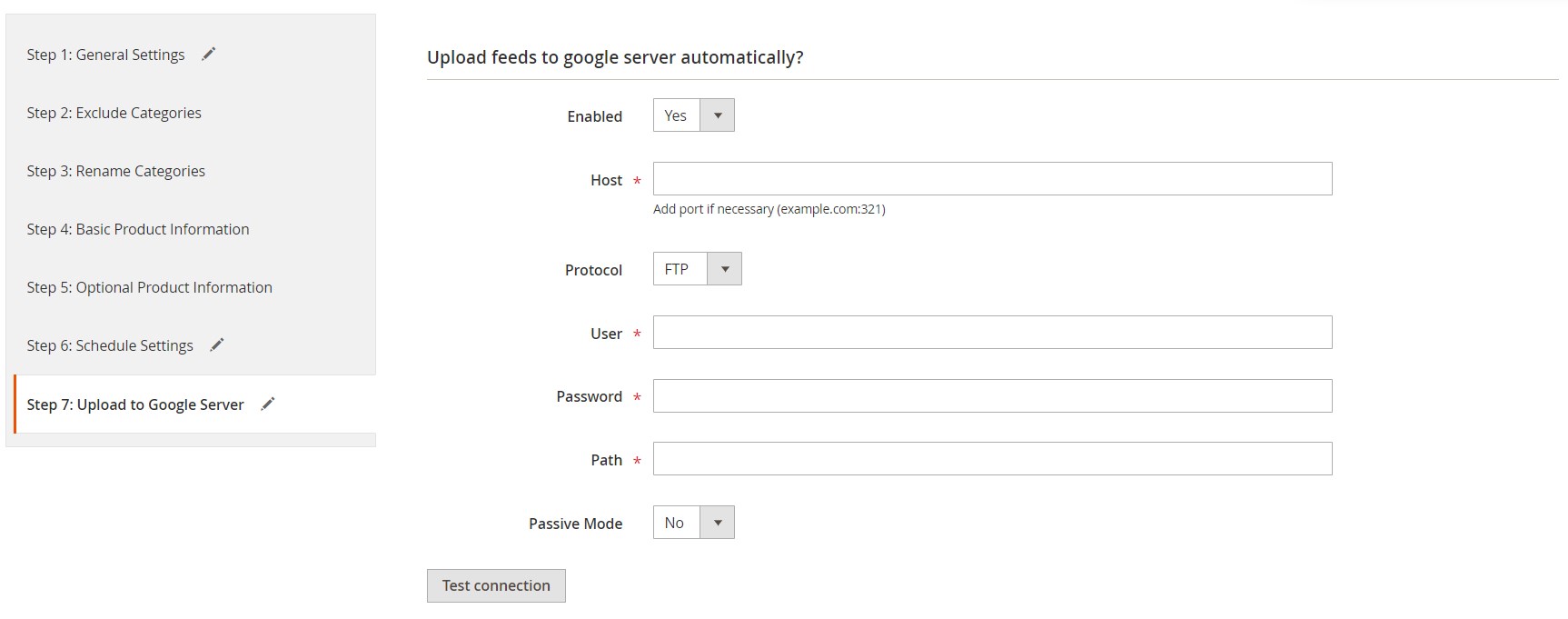
After you fill in all the required information, click on the ‘Save and Start Generation’ button.
As for the main settings of the Amasty Product Feed module for Magento 2, they are divided into 5 sections: General, Email Notifications, Multi-Process Generation, Cronjob Information, and Instagram Feed.
First, you need to specify the number of products to be processed within one iteration (Batch Size) and select one of the options for the “URL with category” setting (Default Rules, Shortest Path, or Longest Path). Next, define the number of items that will be displayed in the feed preview, select a folder for storing feed files (“var” or “pub/media”), and specify a local file path.

In Email Notifications, you select an email sender and enter email addresses for sending notifications. Here, you also choose events that will trigger email alerts, as well as templates for the notifications on successful and unsuccessful feed generation.
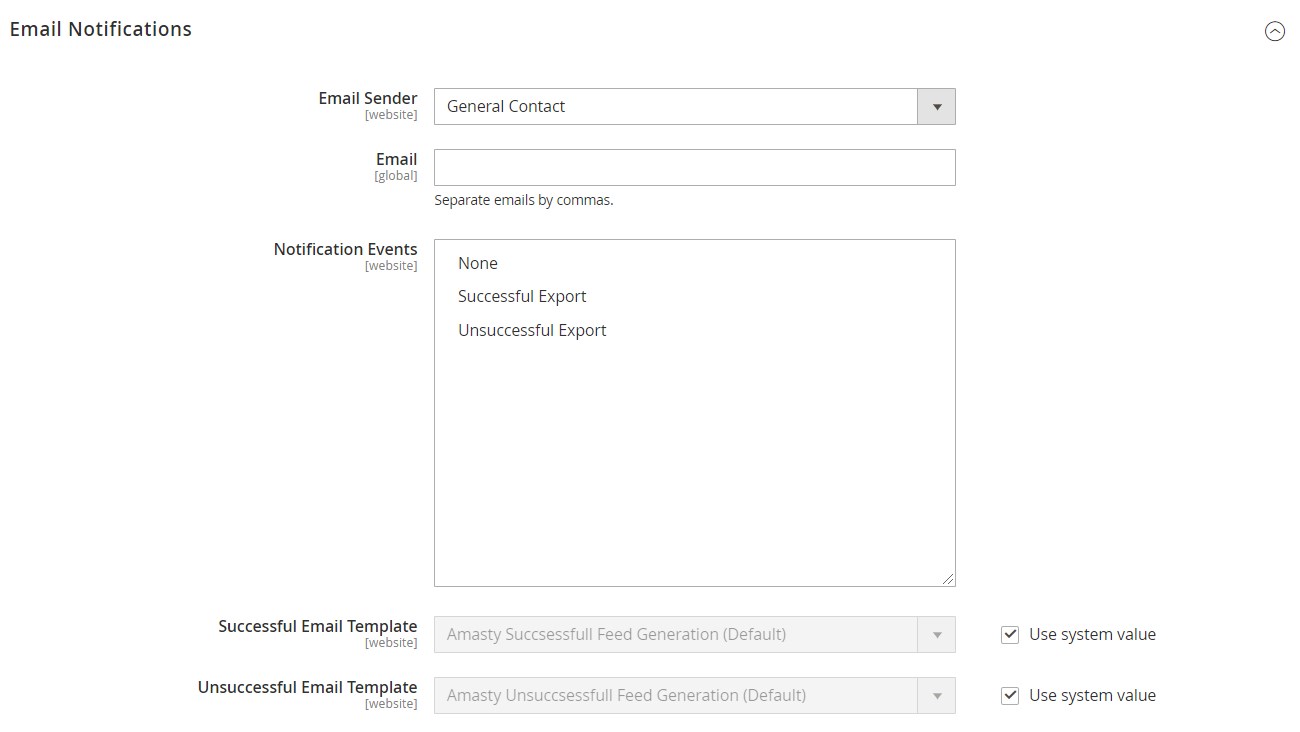
In the following settings section, you can enable the multi-process generation feature and set the number of parallel processes.

In Cronjob Information, you can check details of the latest cron jobs.

The last section of settings can be configured if you have the Amasty Instagram Feed extension installed on your store.

Recent Updates
Magento 2 Product Feed 2.5.1
- Now it is possible to set multiple threads for feed generation.
Magento 2 Product Feed 2.4.0
- Now 4 templates are available for Amazon.
- A new setting was implemented: the ability to choose a folder (var or media) for saving generated feeds.
Magento 2 Product Feed 2.3.5
- The extension was covered with Unit Tests.
Magento 2 Product Feed 2.2.8
- New modifiers were added: ‘if not empty’ and ‘if empty/not empty’.
- Now it is possible to use an image of the parent configurable product for a child simple product.
- Now it is possible to manage all cron tasks on the Cron Tasks List grid.
- An optional modifier that allows hiding attributes with an empty value was added for XML feeds.
- Improvements for the feed generation pop-up window were performed.
- New option: the preview of a feed format without the feed generation.
Magento 2 Product Feed 2.1.0
- Now admin users can see hints for category names according to the Google Taxonomy.
- Options from the Custom Feed generation were added to the Google Feed Wizard.
Magento 2 Product Feed 2.0.0
- New modifiers were added: Uppercase, Capitalize, Round, If Empty, To secure URL, and To unsecure URL.
- New options for Custom Fields were implemented: change the price; replace the value with text.
- Now it is possible to send email notifications on successful and unsuccessful feed generation.
- Redesign of the feed generation queue settings.
Magento 2 Product Feed 1.9.1
-
A new feature was added: the creation of custom fields based on the specified rule conditions.
Magento 2 Product Feed 1.8.2
-
Now it is possible to add a timestamp of the feed creation in the XML feed header.
Magento 2 Product Feed 1.6.0
-
New options: disabled, not visible, and out of stock products can be excluded from the product feed.
-
Possibility to copy a link to the custom feed on the product feed grid in one click was implemented.
Magento 2 Product Feed 1.5.6
- The information section was added to the Configuration page.
- Now it is possible to export the “Product ID” attribute.
Magento 2 Product Feed 1.4.0
- Google Feed Wizard was introduced: now it is possible to create a product feed for Google Merchant in 4 easy steps.
Magento 2 Product Feed 1.3.1
- Magento 2.2 compatibility was introduced.
Magento 2 Product Feed 1.2.0
- A new option was added: now you can control whether the shortest or longest category path will be used in the output URL.
- ‘Product Enabled’ and ‘Stock Availability’ conditions are now available by default.
Final Words
Amasty Product Feed for Magento 2 is an easy-to-use tool for generating advanced product feeds. With the help of the Magento 2 product feed extension, you will connect your Magento 2 store to various third-party engines without any headaches. The price of the module is $199.
Keep in mind that FireBear offers a free Product Feed Export add-on for Magento 2 that allows you to transfer your product feeds to such famous marketplaces as Google Shopping, Yandex Market, eBay, Facebook Page Shops, Amazon (Inventory, Marketplace, Ads), etc.
Get/Buy Free Product Feed Export add-on for Magento 2







